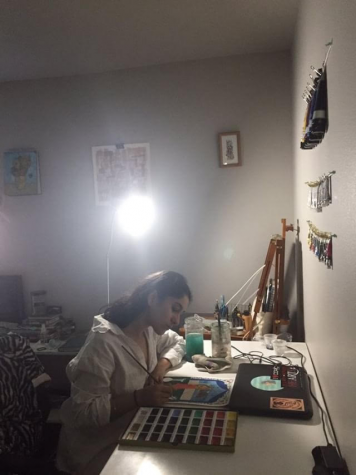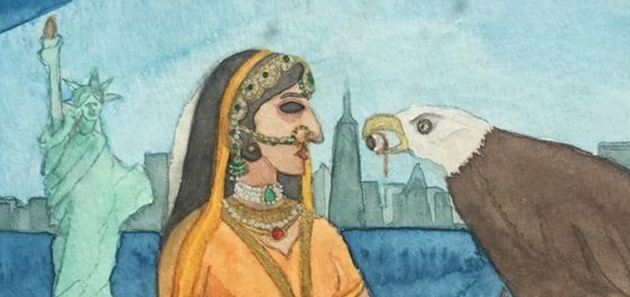Jasleen Kaur’s personal, cross-cultural, vibrant art

When I became the Arts and Entertainment editor, I knew that I wanted to put the spotlight on the amazing artists that walk Wilsonville’s halls. When junior Jasleen Kaur gave her presentation of her summer work in advanced art, I immediately knew who I wanted to profile first. Her story was so unique and her art was gorgeous and had a deep history. I was enthralled and I wanted to know more about the deep well of inspiration she draws from.
Isaac Boger: Your art four presentation was amazing, can you explain your concentration for this year?
Jasleen Kaur: Thank you! For my art four concentration I knew that I wanted to do something connected to my background, because, you know, as an artist, you have sources of inspiration other than your own personal experience, but that also factors in a lot. I just think that personal experience is the hardest thing to make art about.
Shotola said to me that I should pull from my background, because it’s sort of unusual here, and people are not exposed to a lot of stories like mine. I thought maybe I could do something about the life of an immigrant, the story of cultural assimilation from being so Indian to being so American. My feelings about both of my countries are so jumbled up. India is so culturally backwards; I read on the news today that they just legalized gay intercourse, and America is obviously very divided right now too, so I have a love-hate relationship with both of them. My concentration is just my messy feelings about my background.
IB: You moved from India to the US 5 years ago. How has that shift influenced your art?
JK: I was never an artist in India, I had a bunch of crayons and I would do some scribbles but that’s it. The US is where I really discovered I could be an artist and make an income by making art. India values its engineers and doctors, but not the humanities and arts. If I were to say to my family, “Hey maybe, like, I’ll do art!” They’d say, “That’s not going to make you money.” So a few years after I came here, I started taking art seriously. I think this country has a lot of freedom of choice.
IB: Were there any artists that you saw when you came over that made you realize that art could be a future for you?
JK: My art teachers. My teachers are extraordinary. I’ve really found a new home here in this school.
IB: Which artists/art styles inspire you the most now?
JK: I can find an appreciation for every single type of art. The art that you do is just really out there and interesting to look at and has some sort of a quirky feel, like what’s going on here? There’s abstract art and there’s photorealism, etc. I admire everything, but I really love bright colors. Black and white doesn’t really appeal to me, why would you even use it anymore if we have color technology? I mean, someone could change my mind probably! I love the Mughal art that I showed in my presentation, just historical art that’s colorful and tells a story, or portrays historical or religious figures. When they didn’t have perspective figured out and everything was on a vertical plane instead of going back in space. I think it looks cool; it’s kind of distorted.
IB: So would you say that Mughal art is the main influence for your concentration?
JK: I would say so.
IB: You work with a lot of watercolor. Why do you think you gravitate towards that and what other mediums do you enjoy working with?
JK: Watercolor was my first love. The transparency is so fun to to work with, you can keep layering and layering, and all the layers show through. I love the luminosity of watercolor! But I think it’s just something that I’m really comfortable working in. I think the look of some acrylic paintings, like Mr. Shotola-Hardt’s work, is really amazing, and your work, you can still get that glow, but I haven’t mastered acrylics yet because I don’t use them.
IB: How do you want to challenge yourself art-wise this year?
JK: I just want to make art about topics that are uncomfortable for me, I think I have a lot of controversial opinions. For example, criticising American society, people are doing that because it is worth criticising, but also Indian society. It is worth criticism because Indians are really full of themselves. I was. I always thought, “Wow, my country’s great, my religion is the best,” but we don’t have good free education in India, we don’t have abundant resources for everyone, there’s not many lgbt or women’s rights, there’s no laws against domestic abuse, domestic rape, nothing. Women are still seen as inferior in many areas, even though it is much better than it used to be. I really want to portray that India doesn’t value its women still. It’s kind of a close-minded nation.
IB:The lineup of artists in advanced and AP art this year is amazing. How do your classmates inspire you?
JK: Oh my god, your art gives me retro alien vibes you know? I don’t know how else to describe it. Wren Perot, her pieces look stunning, Julia Soares, she did animals and compositions with them, her style is really fun. We still have a lot of people left (to present).
IB: Yeah, I’m excited to see what people have!
JK: Man, but the people are really good, their ideas are really eloquent.
IB: Can you describe the piece you are currently working on?
JK: The piece I’m currently working on portrays a Mughal lady who is holding a bald eagle in her hand, while the eagle has her eye in its beak. It came from stories my grandmother used to tell me of eagles snatching people’s eyeballs out if they looked at them. We were always told, “If you see an eagle in the sky, don’t look at it, look at the ground.” She told me once, when she was at school, they didn’t have proper buildings, it was held outside, and a girl in her class was staring at the sky, not paying attention, and an eagle flew down and snatched her eyeball out. I don’t know if that actually happened but it’s a good story. I chose a bald eagle to portray because it is supposed to symbolize the fierce independence and strength of the US. The painting for me is a nod to how blinding being in this society is to anything else going on outside. I feel like that sometimes about my own mother country, I don’t really know what’s going on there. In the back of the window I put the New York City skyline and the Statue of Liberty, I think of them as a symbol of hope and acceptance for immigrants. When we came to the United States we landed in New York City and I’ve dreamt of NYC for as long as I can remember, even as a child in another country. It’s the city of hard workers.
IB: Have you been back to New York City?
JK: Yeah actually, I have! You know, it’s a good chaotic. I’d love to live there someday but its so pricey.
IB: Ok, and for my last question, what makes you the happiest?
JK: Oh, I’m just happy doing whatever, sitting at my table and drawing for a few hours, just regular life. I’m grateful that my parents sacrificed so much so I can live in this country and get a good education, and have as many freedoms and opportunities as I do.











